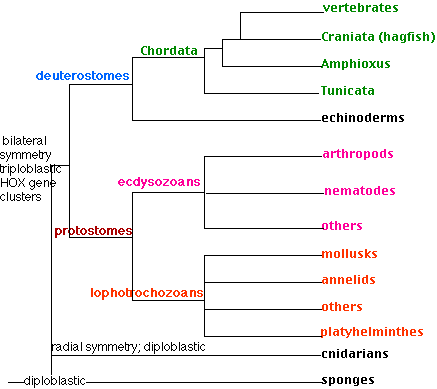
- We do not yet know from what group(s?) of eukaryotes the animals evolved.
- It occurred in Precambrian times.
- Before the Cambrian was far along, most of the animal phyla had appeared.
- So each of the phyla described in this section has had a long, independent history.
- The rapid (geologically speaking!) diversification of the animals has made it difficult to establish the genealogical relationships between them — even using molecular data.
- Our best guesses are shown in the figure (cladogram) on the right.
Sponges are
- sessile, spending their lives anchored to a solid surface underwater.
- Most are marine although some live in fresh water.
- diploblastic; that is, the body wall is made of two layers of cells with a jellylike mesoglea between them;
- The body wall is perforated with pores (hence the name Porifera) through which water containing food particles is filtered. The water is drawn in through the pores by collar cells like those found in choanoflagellates.
- dispersed by small, free-swimming larvae;
- about 10,000 species known
Characteristics:
- diploblastic; two layers of cells — ectoderm and endoderm — with a jellylike mesoglea between them;
- predominantly radial symmetry: body parts (e.g., tentacles) arranged in whorls. However, in some sea anemones, there is only one plane through the tubular body that divides it into two mirror-image halves; thus revealing bilateral symmetry.
- cnidoblasts: specialized cells that secrete a stinging capsule called a nematocyst.
- Food is taken through a mouth into the gastrovascular cavity. The cavity is also called a coelenteron and for many years the name of this phylum was Coelenterata. There is no anus.
- Sexual reproduction produces a free-swimming, ciliated larva called a planula.
- The phylum contains about 10,000 species distributed in 3 classes:
- Hydrozoa
Although the freshwater hydra is a much-studied representative, it is not typical of the class.
Most members are
- marine
- colonial
- produce two body forms: the sessile polyp (like the hydra) and the free-floating medusa (which disperses the species)
- Scyphozoa
Jellyfishes (the medusa stage is dominant). The jelly of the medusa is a much-enlarged mesoglea.
- Anthozoa
Sea anemones and corals. Have only the polyp stage.
All the remaining groups of animals belong in a clade whose members share:
- bilateral symmetry (hence the name); that is, dorsal-ventral and left-right axes
- triploblastic (three tissue layers: ectoderm, mesoderm, endoderm)
- HOX genes in one or more clusters with the genes within a cluster arranged in the same order as the body parts they affect.
The bilaterians contain two clades, the protostomia and the deuterostomia.
Long before the days of genome analysis, taxonomists were convinced of a fundamental division in the animal kingdom between the
- protostomes ("first mouth") and the
- deuterostomes ("second mouth").
| Protostomia |
Deuterostomia |
| Blastopore forms future mouth and anus |
Blastopore forms future anus only. Mouth forms later. |
| Few HOX genes for the posterior |
Multiple HOX genes for the posterior |
| Spiral cleavage of embryo |
Perpendicular cleavage planes in embryo [View] |
| Early cleavage cells committed [Link]; no identical twins |
Early cleavage cells totipotent; identical twins possible |
| Coelom arises by splitting of mesoderm |
Coelom arises between invaginating mesoderm during gastrulation |
| Lophotrochozoans and Ecdysozoans |
Echinoderms, Acorn worms, and Chordates |
Genome analysis, especially the analysis of
supports a major division of the Protostomia into two superphyla:
- Lophotrochozoans and
- Ecdysozoans
Their name was created from the names of formerly-separated groups that have now been joined in a single clade on the basis of the similarities of their genomes:
- They all share a cluster of HOX genes quite different from those found in the ecdysozoans (and deuterostomes).
- They share similar sequences in their 18S rRNA genes.
The clade contains a number of phyla of which we shall examine only 3.
- annelids (Annelida),
- mollusks (Mollusca), and
- flatworms (Platyhelminthes).
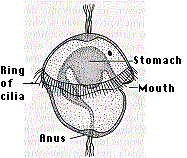 Characteristics:
Characteristics:
- segmented; that is, their body is made up of repeating units. Although some structures, e.g., the digestive tract, run straight through, others like the excretory organs are repeated in each segment.
- The major nerve trunk runs along the ventral side.
- a large, fluid-filled coelom; It is lined with mesoderm and enables the internal organs to slide easily against one another making for easy locomotion.
There are about 12,000 species known, distributed among the
- Oligochaeta (the common earthworm is a member)
- Polychaeta (marine forms such as the clam worm). These animals produce a free-swimming trochophore larva (figure), which partly accounts for the name Lophotrochozoan.
- Hirudinea; the leeches.
With 70,000 living species (perhaps only a third of the number out there), the mollusks must be counted as among the most successful animals on earth today.
Most belong to the first 3 of the 6 classes shown here:
- Bivalvia.
Two shells encase the body. Includes the clams, mussels, oysters, and scallops.
- Gastropoda.
Snails and slugs. Snails have a single shell ("univalves') while slugs have none.
- Cephalopoda.
This marine group includes the various species of octopus, squid, as well as the chambered nautilus. A record 28-foot octopus and 60-foot (18 m) squid make these the largest of all the invertebrates.
- Scaphopoda.
Marine, filter-feeding "tooth shells".
- Amphineura.
Includes the chitons, whose shell is made of 8 overlapping plates ("polyplacophora")
- Monoplacophora.
Until a live specimen was discovered in 1952, these animals were thought to have been extinct for millions of years. It has a single shell (hence the name) and, unlike the other mollusks, is segmented (as are its relatives the annelids).
The trochophore larvae of mollusks is also evidence that they belong in the same clade with the annelids.
This phylum contains some 20,000 species distributed among three classes:
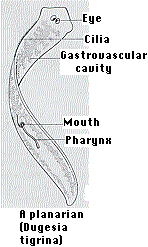
- Turbellaria, free-living forms of which the planarian (right) is a commonly-studied example.
Planaria share with the other members of the phylum
- a flat, almost ribbonlike, shape
- bilateral symmetry.
The bilateral symmetry of planarians is associated with
- active locomotion
- by secreting a layer of mucus underneath them and propelling themselves forward with the many cilia on their ventral surface.
- and by swimming.
- a concentration of sense organs in the head (called cephalization).
Planarians feed through a mouth on their ventral surface. It leads to an elaborate gastrovascular cavity. But there is no separate exit so undigested food has to leave by the mouth.
- Trematoda, a group of parasitic

- lung flukes
- liver flukes and
- blood flukes (e.g., Schistosoma)
All of these have at least two different stages in their life cycle, each parasitic in a different host — one of which is usually a snail.
The diagram gives the life cycle of the blood fluke, Schistosoma mansoni. Once within the alternate host, a snail, a single miracidium may produce as many as 200,000 infectious cercariae. Both sexes must infect the human if the cycle is to continue. With the increasing use of irrigation in tropical regions, the incidence of human infection is rising alarmingly.
- Cestoda; the parasitic tapeworms. They, too, alternate between an intermediate host (e.g., pig, fish) and a definitive host (e.g., us). The growing popularity of sushi and sashimi made of raw Pacific salmon has caused infections by the fish tapeworm to become more common in the U.S.
Although placed here with the lophotrochozoans, the flatworms are sufficiently different from the others in the group that some taxonomists think they should be placed in a superphylum of their own: the Platyzoa.
All the members of this clade
- grow by periodically moulting — shedding their skin or exoskeleton;
- share a unique pattern of HOX genes, e.g. Ubx and Abd-B;
- lack cilia.
The clade includes a number of phyla of which we shall examine 2:
- the nematodes and the
- arthropods.
Features:
- A one-way digestive tract running from mouth to anus.
- A cavity between the digestive tract and the body wall. It develops from the blastocoel and is called a pseudocoel.
- Some 25,000 species have been identified but this may be less than 10% of the true number.
- Most are free-living; found in soil where they are important decomposers.
- One of these is Caenorhabditis elegans, a model laboratory animal.
- Some are parasitic, including
- hookworms (In 2003 the number of humans infected by hookworms was estimated at 740 million worldwide.);
- pinworms;
- Ascaris and
- many parasites of commercially important plants like strawberries and oranges.
- Most are small although one that parasitizes whales reached 30 feet!
Some characteristics:
- Incredible diversity. Over a million living species have been identified so far — more than all the other species of living things put together — and this is probably only a fraction of them.
- Live in every possible habitat: fresh water, salt water, soil, even in the most forbidding regions of Antarctica and high mountains.
- A jointed external skeleton made of chitin, a polymer of N-acetylglucosamine (NAG).
- Segmented.
- Pairs of jointed appendages; one pair to a segment — used for locomotion, feeding, sensation, weaponry.
- Bilateral symmetry.
- Main nerve cord runs along the ventral side.
We shall look at four groups (subphyla):
- Crustacea
- Hexapoda (the insects)
- Myriapoda
- Chelicerata
- Head and thorax fused into a cephalothorax.
- At least 40,000 species.
- Most are aquatic, found in both fresh water and in the oceans.
- Includes crayfish, lobsters, barnacles, crabs, shrimp.
- Body segments grouped into head, thorax, and abdomen.
- Each of the 3 thoracic segments carries a pair of legs (hence the 6-legged "hexapoda")
- Many have wings, usually 2 pairs (only one pair in flies — diptera).
- Gas exchange through a tracheal system.
- Nitrogenous waste is uric acid thus conserving water.
- Some 950,000 species, and this may be only 10% of the number out there.
- Dominate all habitats except for the oceans.
- Most intensively-studied representative: Drosophila melanogaster.
- Representative colonial insect: the honeybee, Apis mellifera
Table listing some of the insect orders.
Some 13,000 species of
- centipedes and
- millipedes
- Anterior segments fused into a cephalothorax.
- The first pair of appendages — the chelicerae — are used for feeding.
- There are no antennae.
- Includes:
- Merostomata. The only member alive today is Limulus, the horseshoe "crab".
- Arachnids (some 75,000 species)
- 8-legged
- scorpions, mites, ticks, spiders, daddy longlegs.
They are uncertain. The great diversification of the arthropods occurred so long ago (in the Precambrian) that even gene sequences have as yet been unable to create unambiguous phylogenetic trees. However, there is increasing evidence that Hexapoda and Crustacea make up one clade; Myriapoda and Chelicerata another.
The features of these animals are listed above. The most prominent members of this group belong to the echinoderms and the chordates.
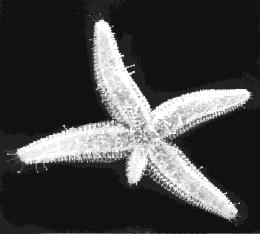 Characteristics:
Characteristics:
- radial symmetry. HOWEVER, their larvae have bilateral symmetry so the echinoderms probably evolved from bilaterally symmetrical ancestors and properly belong in the Bilateria.
- water vascular system. Seawater is taken into a system of canals and is used to extend the many tube feet. These have suckers on their tips and aid the animal in attaching itself to solid surfaces.
- About 6,000 species — all of them marine.
There are 5 classes of echinoderms:
- Sea urchins and sand dollars (Echinoidea)
- Sea lilies (Crinoidea)
- Starfishes (Asteroidea) The photo (courtesy of Dr. Charles Walcott) shows a starfish that lost an arm and is in the process of regenerating another.
- Brittle stars (Ophiuroidea)
- Sea cucumbers (Holothuroidea)
During their embryonic development, all chordates pass through a stage called the pharyngula [View] with these features:

- a dorsal, tubular nerve cord ("1") running from anterior to posterior. At its anterior end, it becomes enlarged to form the brain.
- a flexible, rodlike notochord ("2") that runs dorsal to the digestive tract and provides internal support. In vertebrate chordates, it is replaced by a vertebral column or backbone long before maturity.
- pairs of gill pouches. These lateral outpocketings of the pharynx are matched on the exterior by paired grooves. In aquatic chordates, one or more pairs of gill pouches break through to the exterior grooves, forming gill slits ("3"). These provide an exit for water taken in through the mouth and passed over the gills.
- a tail that extends behind the anus
The vast majority of chordates have a skull enclosing their brain (Craniata), and all but one of these (the hagfish) convert their notochord into a vertebral column or backbone. These latter are the vertebrates.
Vertebrates also differ from all the other animals by having quadrupled their HOX gene cluster; that is, vertebrates have 4 clusters of HOX genes located on 4 different chromosomes.
| The vertebrates are described in a separate page. Link to it. |
Here we shall examine two groups of invertebrate chordates:
- Urochordata and
- Cephalochordata
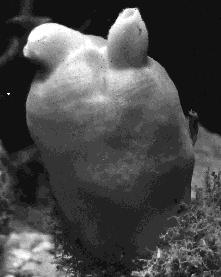 This group (also called Tunicata) includes animals known as ascidians (and commonly called sea squirts). They are
This group (also called Tunicata) includes animals known as ascidians (and commonly called sea squirts). They are
- marine
- sessile animals that
- feed by filtering food particles from seawater taken in through one opening, or siphon, and squirted out the other.
The one on the right is Halocynthia, the sea peach (photo courtesy of Ralph Buchsbaum).
It is hard to see what makes these animals chordates. The adults have neither notochord nor a dorsal tubular nervous system.
However, these animals disperse themselves with free-swimming larvae that have both notochord and a dorsal tubular nervous system (see the diagram above).
One of the most common species (Ciona intestinalis) has been suggested as an excellent candidate for genome sequencing because
- it has a very small genome (~1.6 x 108 base pairs encoding ~16,000 genes).
- Its larva is small (with ~2,600 cells) including only
- 36 muscle cells
- 40 notochord cells
- 100 neurons
- These cells (as well as the others) develop along rigid pathways which can be easily observed because the larva is
- transparent.
All these features are shared with C. elegans, but now we are talking about an animal far closer to the evolutionary line that produced us.
| In the 13 December 2002 issue of Science, a team of 87 (!) authors reported preliminary results of their sequencing of the Ciona intestinalis genome. |

The representative member of this tiny subphylum of so-called lancelets is a small (5 cm), marine, fishlike creature called amphioxus (on the right). (For years its genus name was Amphioxus but that has now been replaced by the name Branchiostoma.)
Amphioxus retains:
- a dorsal nerve cord
- notochord and
- gill slits
throughout its life.
There is a small cluster of neurons at the anterior tip of the nerve cord with certain similarities of structure and gene expression to the vertebrate fore-, mid- and hindbrain.
Although able to swim, the lancelet spends most of its time partially buried in the sand while it filters microscopic food particles from the water.
20 October 2005


 Characteristics:
Characteristics:

 Characteristics:
Characteristics:


